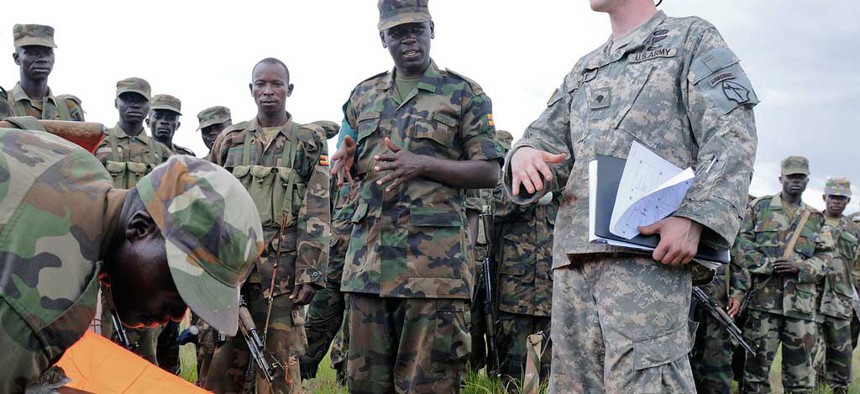
U.S. Army photo by Sgt. 1st Class Brock Jones
Is There More to the U.S. Mission in Uganda Than Finding Kony?
The U.S. sent Special Forces to Uganda to intensify the hunt for the infamous warlord Kony. But is it just part of a larger plan to contain the growing conflict in Africa? By Hilary Matfess
This week, President Obama took military action. But it wasn’t in Ukraine or Syria. Instead, he notified Congress of the deployment of 150 special forces troops and CV-22 Osprey aircraft to Uganda in order to provide support for the African Union task force charged with locating Joseph Kony, the leader of the brutal Lord’s Resistance Army (LRA).
Initial reactions to the news focused on the fraught relationship between the United States and Uganda, especially following Uganda’s recent adoption of legislation targeting homosexuals. But such analysis overestimates the importance of Uganda in this latest U.S. deployment. Obama’s military commitment represents an intervention of sorts in the crisis in the nearby Central African Republic, at a time when the EU is struggling to launch a peacekeeping force in the country and the UN is debating doing the same, amid U.S. reluctance to fund the mission.
Two years ago this month, Joseph Kony gained widespread notoriety in the United States following the release of “Kony 2012,” a video produced by the advocacy group Invisible Children. The International Criminal Court has charged the warlord with 33 counts of war crimes and crimes against humanity, and he has reportedly taken refuge in the jungles between Uganda, South Sudan, and the Central African Republic. His army is thought to have dwindled to fewer than 250 soldiers.
But even in this anemic state, the LRA appears to have shifted its focus away from Uganda and begun conducting raids in the eastern regions of the Central African Republic. One report found that since May 2013, the LRA has abducted more than 200 people in areas controlled by predominantly Muslim Seleka. In addition to the human cost of these raids, which often include mutilation and sexual violence, they have also exacerbated tensions in the Central African Republic, even if LRA activities are only a small part of the cataclysmic violence in the country. The U.S. forces headed to Uganda will help the African Union track Kony and the LRA across Congo, Uganda, South Sudan, and the Central African Republic.
The conflict in the Central African Republic is essentially a power-sharing dispute that has divided the country along religious lines, pitting Christians against Muslims in a cycle of reprisal killings that have turned the capital into a refugee tent-city. In recent meetings on the crisis at the United Nations, American diplomats have expressed concerns about Congress funding a costly peacekeeping mission in the country. Given the American public’s war-weariness following Iraq and Afghanistan, Obama is unlikely to provide robust American support for an intricate peace-building process with a low chance of success.
But however unpalatable intervention is, greater instability in the Central African Republic is also undesirable. A festering conflict could make the region more attractive for criminal and terrorist networks—especially given that both South Sudan and the Democratic Republic of the Congo, which border the Central African Republic, are embroiled in their own domestic conflicts. Keep in mind that instability in Somalia contributed to the tragic terrorist attack at the Westgate shopping mall in neighboring Kenya, in which 67 people were killed and more than 120 injured by members of the militant group al-Shabab.
All of which raises the question: What exactly is the U.S. hoping to achieve by sending Ospreys and special forces to Uganda? Is it simply an effort to intensify the hunt for Kony, or is it an attempt by the Obama administration to contain the conflict in the Central African Republic without committing to the peace-building process the country so desperately needs?
NEXT STORY: Newt Gingrich’s Plan to Save the World



